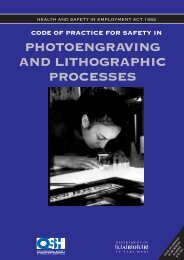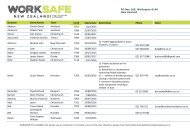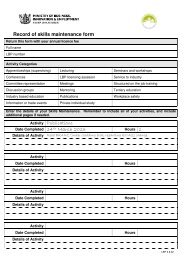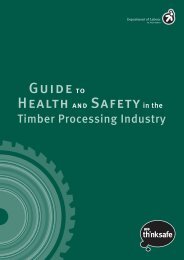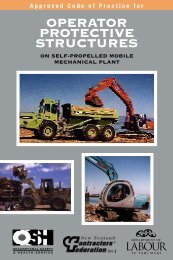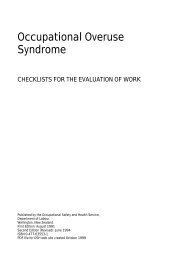Total Restraint System: Factsheet 6. Working ... - Business.govt.nz
Total Restraint System: Factsheet 6. Working ... - Business.govt.nz
Total Restraint System: Factsheet 6. Working ... - Business.govt.nz
Create successful ePaper yourself
Turn your PDF publications into a flip-book with our unique Google optimized e-Paper software.
PreventING falls<br />
from height<br />
<strong>Factsheet</strong> 6: <strong>Total</strong> <strong>Restraint</strong> <strong>System</strong><br />
This factsheet will help you to select and use a<br />
total restraint system (sometimes referred to as<br />
a travel restraint system) for working safely at<br />
height. This factsheet is one of six factsheets in the<br />
<strong>Working</strong> Safely at Height Toolkit to be used together<br />
with the Best Practice Guidelines for <strong>Working</strong> at<br />
Height in New Zealand.<br />
■■What do I need to know about total restraint<br />
systems?<br />
A total restraint system is a full-body harness that is<br />
connected by an energy absorbing lanyard to a suitable<br />
anchorage point or horizontal lifeline. The system is set up to<br />
keep the worker from reaching the edge.<br />
A total restraint system is the preferred control for<br />
preventing falls from roofs on single-storey buildings when<br />
edge protection is not practicable.<br />
■■How do I use a total restraint system?<br />
Ensure the system is installed and used, or its installation and<br />
use is directly supervised, by a trained and competent person.<br />
A competent person must install a temporary roof anchor<br />
that is used as an anchorage for a total restraint system.<br />
This must be done in accordance with the manufacturer’s or<br />
designer’s instructions.<br />
The roof or other building component that an anchor is<br />
attached to must be checked by a competent person to<br />
verify that it is suitable for supporting the anchor. Workers<br />
must not work alone when using a total restraint system.<br />
DOL 12042.6 MAR 12<br />
■■What does “trained and competent” mean?<br />
A trained person knows:<br />
• how to correctly fit and attach the safety harnesses<br />
• the dangers of using incompatible hardware (e.g.<br />
harnesses and lanyards from different systems)<br />
• how to inspect, maintain, and store the equipment<br />
• how to correctly anchor, install, and use the total<br />
restraint system.<br />
■■How to get training?<br />
The NZQA Unit Standard 23229 Use a safety harness<br />
for personal fall prevention when working at height is a<br />
recommended competency. Alternatively, you must be able to<br />
demonstrate equivalent knowledge and skills, or equivalent or<br />
a higher international qualification.<br />
A recommended means of obtaining competence for workers<br />
who are involved in planning, installing, operating fall arrest<br />
systems and supervising staff is NZQA Unit Standard 15757<br />
– Use, install and disestablish proprietary fall arrest systems<br />
when working at height or an equivalent or higher level of<br />
qualification. NZQA Unit Standard 23229 is a prerequisite for<br />
achieving NZQA Unit Standard 15757.<br />
■■Is a total restraint system the same as a fall<br />
arrest system?<br />
No. A total restraint system isolates the worker from the fall<br />
by keeping them away from the edge.<br />
Fall arrest systems do not prevent the fall, they minimise the<br />
impact of the fall by slowing and arresting a worker’s fall.<br />
The Department of Labour takes no responsibility<br />
For more information about how to work safely at height:<br />
for the results of any actions taken on the basis of<br />
this information, or for any errors or omissions. www.dol.<strong>govt</strong>.<strong>nz</strong>/prevent-falls<br />
0800 20 90 20
PreventING falls<br />
from height<br />
A fall arrest system is an assembly of interconnected<br />
components consisting of a harness which is connected to<br />
an anchorage point by a lanyard incorporating an energy<br />
absorber. They can be used where workers are required to<br />
carry out their work near an unprotected edge.<br />
When fall arrest systems are used an appropriate safety<br />
helmet shall be worn to protect the worker from head injury<br />
during an uncontrolled fall.<br />
Most fall arrest systems require a minimum distance<br />
to deploy, making them inappropriate for low-level and<br />
single-storey work.<br />
Fully assess other controls for managing the hazard of<br />
working at height before deciding to use a fall arrest<br />
system.<br />
For further guidance on fall arrest systems, refer to<br />
AS/NZS 1891.4 Industrial fall-arrest systems and devices –<br />
Selection, use and maintenance, and IRAANZ Industrial Rope<br />
Access in New Zealand Best Practice Guidelines.<br />
This factsheet is part of the <strong>Working</strong> Safely at Height<br />
Toolkit that supports the Best Practice Guidelines for<br />
<strong>Working</strong> at Height in New Zealand.<br />
<strong>Factsheet</strong> 1: Planning a safe approach to working at height<br />
<strong>Factsheet</strong> 2: Selecting the right equipment for<br />
working safely at height<br />
<strong>Factsheet</strong> 3: Short duration work at height<br />
<strong>Factsheet</strong> 4: Edge protection<br />
<strong>Factsheet</strong> 5: Temporary work platforms<br />
<strong>Factsheet</strong> 6: <strong>Total</strong> restraint system<br />
For additional guidance on safe working at height see:<br />
››<br />
Be Safe <strong>Working</strong> on Roofs<br />
››<br />
Safe <strong>Working</strong> with Ladders and Stepladders<br />
››<br />
Health and Safety In Contracting Situations




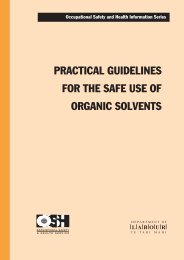
![Task analysis worksheet [161 KB PDF] - Business.govt.nz](https://img.yumpu.com/51400981/1/190x135/task-analysis-worksheet-161-kb-pdf-businessgovtnz.jpg?quality=85)

